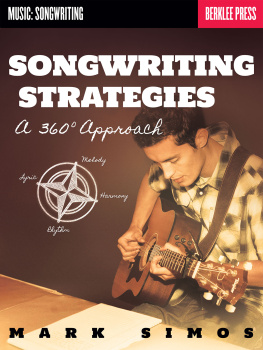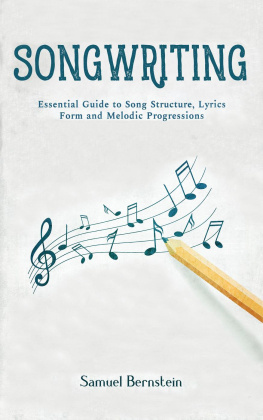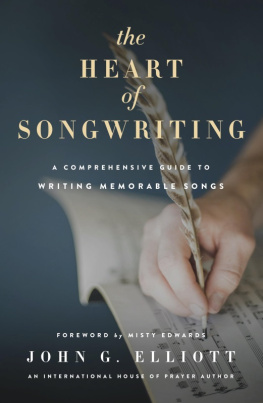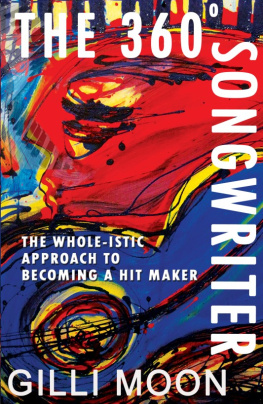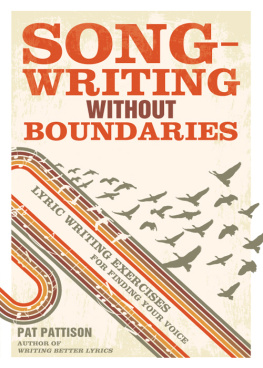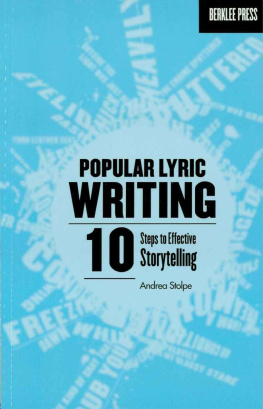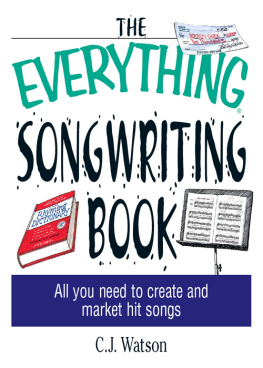Berklee Press, a publishing activity of Berklee College of Music, is a not-for-profit educational publisher.
Available proceeds from the sales of our products are contributed to the scholarship funds of the college.
Contents
Melody/Harmony
Connections
Using the Compass:
Further Steps
ACKNOWLEDGMENTS
Chet Atkins once invited jazz guitarist George Van Eps to play a concert for the Nashville chapter of the Musicians Union. At the shows end, Chets buddies urged him to play a number himself. That would be like following behind a snow plow with a spoon, he said.
I feel a lot like thattrying to explicate a bit of the magic in the masterpieces of many songwriters, famous or obscure, whose work still inspires me. My 360 songwriting approach, described in this book, formalizes practices and discov-eries made by these songwriters. Though often working intuitively, collectively they have scouted every pathway described in this book, and many more besides.
I developed 360 songwriting over the course of many decades of observing and documenting my own creative process and experienceas a songwriter and co-writer, tunesmith and composer, musician, and teacher. Ive learned especially from other writersfrom their books and classes, from interviews and anecdotes, and by talking, co-writing, and teaching with them. Ive been privileged to co-write with, and thus learn directly from, some truly great writers: Lisa Aschmann, Jon Weisberger, John Pennell, Becky Buller, Catie Curtis, Jimmy Barnes, Bob Carlin, Viktor Krauss, Andy Hall, Lisa Shaffer, Alana Levandoski, and Sarah Siskind, among many others.
If were lucky, we songwriters also get to learn from artists who sing our songs. Of the many artists who have performed and recorded my songs and tunes, I offer special thanks to Laurie Lewis, who first heard the night bird sing, and to Alison Krauss, who showed some crazy faith.
Many exercises and practices in this book were developed and presented over the years in songwriting workshops, critique sessions, music camps, retreats, and in more extended classes at Club Passim School of Music and New England Conservatory. A teaching tour to New Zealand/Australia in summer 2010, organized by Clare McLeod, and especially a key discussion with Anne Maree Wilshire, began a long new germination period of shaping 360 songwriting principles into this book. The underlying creative philosophy of this book also reflects many sources and influences beyond songwriting and music, especially my studies with master movement teacher Jaimen McMillan, founder of Spacial Dynamics.
This work came to fruition in an amazing community of musicians and musical thinkersBerklee College of Music. Since 2005, teaching songwriting at Berklee has provided me with continuing invaluable opportunities to field-test and refine these techniques. Ive been able to build on a legacy of seminal work in songwriting pedagogy contributed by my Berklee colleagues, and those working with their approachesin particular, the published works of Pat Pattison, Jack Perricone, Jimmy Kachulis, Andrea Stolpe, and John Stevens, among others. Many other colleagues have generously shared their knowledge and experience, as Ive observed their classes or cornered them in delightful afternoons of intense conversation: in Songwriting, the late Henry Gaffney, Scarlet Keys, Susan Cattaneo, Jon Aldrich, Stan Swiniarski, Dan Cantor, Melissa Ferrick, Ben Samama, and Bonnie Hayes; throughout the college and wider community, Allen LeVines, Steve Kirby, Scott McCormick, Sarah Brindell, Mick Goodrick, Matthew Nicholl, Joe Mulholland, Kari Juusela, Keppie Coutts, and Christiane Karam. I owe a particular debt to Matt Glaser, Bruce Molsky, Berklees American Roots Music Program, and Bostons rich and varied quiltwork of roots music communities; and to Michael Wartofsky and members of NOMTI (New England Opera and Musical Theater Initiative).
To pull it all together, Ive been privileged to work with a great music book editora true old-school editor, ruthless and (almost) always rightmy cheerful nemesis Jonathan Feist and his teams at Berklee Press and Hal Leonard. Many colleagues mentioned above served as beta readers and commenters on early drafts of the book, in addition to the keen-eyed close reading of Rujing (Stacy) Huang.
They say if you want to learn something, teach it. At the root of all this has been the privilege of working with many talented, insightful, dedicated, fearlessand tolerant!student songwriters and friends, who have accompanied me, as coexperimenters and fellow travelers, in developing and refining these ideas.
Three women have deeply shaped my relation to the creative spirit, honored in these pages. I learned first lessons in creativity from my late mother, Bertha Claire Goldfarb Simos, who brought home rolls of butcher paper on which I happily drew endless maps of imaginary countries. My sister Mimi is always a source of inspiration and encouragementin the truest sense. A well-known writer (under her nom de broom ), she told me the hardest thing about writing a book, or any extended work, is managing ones own fluctuating emotions. She was right, as usual. My beloved wife Pampatient, wise, and more forgiving of me than I am of myselfhas served a long vigil as midwife to this awkward babe of a book. On an afternoon walk along a tree-lined street in Vancouver, in summer 2010, she challenged me to take the time to make this book what she knew I wanted it to be. Neither of us knew what we were in for.
INTRODUCTION
This book presents a repertoire of songwriting strategies : practical strategies for writing songs, and learning strategies and exercises to help you advance as a songwriter. Using the tools and techniques described in this book, youll be able to draw on a broader range of sources of inspiration and starting points for songs. And youll be able to work with this material to write songs in more versatile and innovative ways.
I call this approach 360 songwriting . Its grounded in a comprehensive model that encompasses and integrates four primary facets of songwriting: rhythm, lyrics, melody, and harmony. Each facet can connect directly to imagery, narrative, and emotion in the world, and each can also express structure and form in unique ways. This opens up a rich repertoire of strategies and skills for songwriters. We can start a song from seed material in any facet, and follow pathways to related material in any other facet, or cast content directly to material in any of the facets.
Developing the skills to follow these different creative pathways will expand the productivity, scope, and versatility of your writing. It will help you get stuck songs unstuckunfreezing writers block by accessing alternate processes or pathways. Above all, it will help you write better songs : songs with depth, craft, unity, and integritysongs that take chances and stretch boundaries, for you as a writer and for the art of songwriting. As you expand your abilities to work from the full 360, youll be writing songs from all directions, in all directions.

